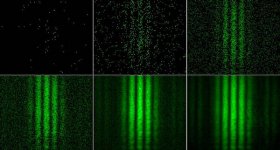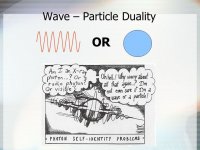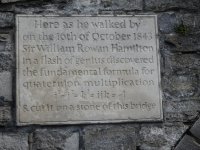@ gpauk
I'm not sure to what "difference" you refer.
It is well known that single photons, separated from each other in time, will eventually build up the interference pattern observed when using a concentrated beam of many photons.
It is the rest of your article that is interesting, and I must study it later - thanks.
I'm not sure to what "difference" you refer.
It is well known that single photons, separated from each other in time, will eventually build up the interference pattern observed when using a concentrated beam of many photons.
It is the rest of your article that is interesting, and I must study it later - thanks.
That's the difference - a single photon doesn't create an interference pattern. It lands in a place that is probabilistically part of a pattern that would form if more were sent. But if you just send one, no pattern.
Yes, gpauk, a single photon does not an interference pattern make.
I understand that each photon carries its own 'probabilty function' which will determine its position on the screen.
To the layman it may appear that the successive photons were in cahoots in forming the interference pattern! Weird! 🙂
I understand that each photon carries its own 'probabilty function' which will determine its position on the screen.
To the layman it may appear that the successive photons were in cahoots in forming the interference pattern! Weird! 🙂
The probability function has to do with all possible paths to go there.Yes, gpauk, a single photon does not an interference pattern make.
I understand that each photon carries its own 'probabilty function' which will determine its position on the screen.
To the layman it may appear that the successive photons were in cahoots in forming the interference pattern! Weird! 🙂
I am not sure wether this explains anything.
And who knows wether the photon went through the right slit or the left slit or both or none.
I am not sure wether this explains anything.
I don't think we here are able to explain the process, at least not in terms that make intuitive sense.
Meanwhile, attached is a nice illustration of the build up of an interference pattern by successive individual photons.
Attachments
In gpauk's link, the experimental team looked at the build up of an interference pattern using single electrons.
They ensured (to greater than 99.9999% probability) that only a single electron was present between the source and the detector at any time.
The conclusion is worth quoting here:
I'm happy to accept that and move on! 😎
They ensured (to greater than 99.9999% probability) that only a single electron was present between the source and the detector at any time.
The conclusion is worth quoting here:
"Since each electron was detected before the next was emitted, it clearly could not have influenced future electrons that then passed through the slits. As elegantly stated by Feynman, we therefore have to accept that each electron (and indeed all matter) has both a wave-like nature (to create the interference pattern) and must also be considered as an individual particle (since this is what was detected)."
I'm happy to accept that and move on! 😎
The way I understand it, once a photon is emitted, it behaves as a wave in transit. As soon as it interacts with an electron, the wave function collapses and it then behaves as a particle.
My 500 m LY figure was just plucked out of thin air - I’m simply stating that I understand that the photon has a wavefront. I would assume after a long transition time. It would be substantial.
🙂
My 500 m LY figure was just plucked out of thin air - I’m simply stating that I understand that the photon has a wavefront. I would assume after a long transition time. It would be substantial.
🙂
It's a wavicle, I tell you! 😀
We discussed the single photon double slit experiment at some length earlier in the thread.
There are no intuitive explanations of why photons behave like they do, and that is why I am happy to move on. 😎
We discussed the single photon double slit experiment at some length earlier in the thread.
There are no intuitive explanations of why photons behave like they do, and that is why I am happy to move on. 😎
Not at all.I think, Bonsai, that you may be confusing "wave front" with "wave amplitude".
There are no intuitive explanations for how photons behave, so pondering their nature is all the more interesting 🙂
( I am reading a very interesting library book by Lee Smolin at the moment. Called "The Trouble with Physics".
Falls into that category "String Theory is Bunk!", which I always enjoy. At time of writing (2007) he notices that Physics has learned Diddley-Squat since 1981 and the then new Standard Model. 🙂 )
The double-slit experiment is a poor one, IMO. We know that some Quantum Observables do not Commute.
Non-commutation means the order of observation of stuff like position and momentum give different results based on the order in which measurements are done. Not entirely familiar in 2D function of a complex variable, but evident in Hamilton's 4D Quaternions.
Specifically the error is a half unit of the (Reduced) Planck's Constant of Action, which is variously Momentum x Distance moved, Energy x Time or the minimum measureable unit of angular momentum.
And also apples to Information. Which is that which we can know. 😎
The Double-slit experiment is actually measuring wavelength of a prepared photon. Since the Photons are prepared to be a particular wavelength, all the spacing of the diffraction pattern tells you is the wavelength.
So it really tells you nothing! But once you start trying to decide which slit the Photon went through, you are doing a different experiment. To determine position.
This is where Quantum Mechanics gets stubborn. My view is you can only know if a Photon is Left or Right handed polarised. Energy and Momentum depends entirely on your frame of reference. Thus really irrelevant.
Falls into that category "String Theory is Bunk!", which I always enjoy. At time of writing (2007) he notices that Physics has learned Diddley-Squat since 1981 and the then new Standard Model. 🙂 )
The double-slit experiment is a poor one, IMO. We know that some Quantum Observables do not Commute.
Non-commutation means the order of observation of stuff like position and momentum give different results based on the order in which measurements are done. Not entirely familiar in 2D function of a complex variable, but evident in Hamilton's 4D Quaternions.
Specifically the error is a half unit of the (Reduced) Planck's Constant of Action, which is variously Momentum x Distance moved, Energy x Time or the minimum measureable unit of angular momentum.
And also apples to Information. Which is that which we can know. 😎
The Double-slit experiment is actually measuring wavelength of a prepared photon. Since the Photons are prepared to be a particular wavelength, all the spacing of the diffraction pattern tells you is the wavelength.
So it really tells you nothing! But once you start trying to decide which slit the Photon went through, you are doing a different experiment. To determine position.
This is where Quantum Mechanics gets stubborn. My view is you can only know if a Photon is Left or Right handed polarised. Energy and Momentum depends entirely on your frame of reference. Thus really irrelevant.
A photon leaves a star some 5 billion LY distant. The ‘wave front’ of the photon is say 500 million LY across.
The photons emitted by a star travel in all directions and that could be said to constitute a spherical 'wavefront'.
However, if situated an astronomical distance from the star one would receive single photons.
I simply can't imagine that a 5 x 10^21 km diameter spherical 'wavefront' can a property of a single photon. 🌟
Not entirely familiar in 2D function of a complex variable, but evident in Hamilton's 4D Quaternions.
That's a bridge too far for me! 😀
Attachments
Whatever the size of the photons wavefront, it will be large. A photon has no sense of time, and therefore distance as experienced by it surely cannot be how we perceive it.
To return to the double slit experiment, you can move the detector around in front of the slit screen and show that even with single photons it has the wavefront behavior. When the detector is on, no photons are detected behind the slit plate. Turn the detector off and you get photons on the other side of the slit plate. If you move the detector position from left-right in front of the slit plate, photons are detected.
The strange bit is how the wave function collapses when interacting with an electron
To return to the double slit experiment, you can move the detector around in front of the slit screen and show that even with single photons it has the wavefront behavior. When the detector is on, no photons are detected behind the slit plate. Turn the detector off and you get photons on the other side of the slit plate. If you move the detector position from left-right in front of the slit plate, photons are detected.
The strange bit is how the wave function collapses when interacting with an electron
The strange bit is how the wave function collapses when interacting with an electron
Nobody has defined just exactly what goes on when the unobservable wave function collapses.
We should remember that the wave function is simply a mathematical construct that helps predict what measurements we can expect.
Some say that, during an interaction, the wave function doesn't so much collapse as change.
gpauk, you sound like a "String Theorest"! And, TBH, it is hardly worth logging in to read your six word tweets. Shame on you.
String Theory is the worst Physics Theory ever enunciated. OK, most of the World believes this rubbish. 27 0f the 30 Professiorships at the Top US Colleges are invested in this.
Not my problem. They are WRONG. Untested and vague. Hardly the Scientific Method.
What Happens at the end of the universe? If we Live to see it. Which is looking dubious right now.
It's interesting. The nearest Star is the faint Proxima Centauri:
https://en.wikipedia.org/wiki/Proxima_Centauri
You might think Sirius A is more important:
https://en.wikipedia.org/wiki/Sirius
You'd be wrong. Long after Sirius A has burnt out, Proxima will be glowing brightly.
Four Trillion years from now, at 300 times the age of the current Universe, Proxima will finally collapse into a White Dwarf. That's it. Game over.
String Theory is the worst Physics Theory ever enunciated. OK, most of the World believes this rubbish. 27 0f the 30 Professiorships at the Top US Colleges are invested in this.
Not my problem. They are WRONG. Untested and vague. Hardly the Scientific Method.
What Happens at the end of the universe? If we Live to see it. Which is looking dubious right now.
It's interesting. The nearest Star is the faint Proxima Centauri:
https://en.wikipedia.org/wiki/Proxima_Centauri
You might think Sirius A is more important:
https://en.wikipedia.org/wiki/Sirius
You'd be wrong. Long after Sirius A has burnt out, Proxima will be glowing brightly.
Four Trillion years from now, at 300 times the age of the current Universe, Proxima will finally collapse into a White Dwarf. That's it. Game over.
- Status
- Not open for further replies.
- Home
- Member Areas
- The Lounge
- What is the Universe expanding into..


